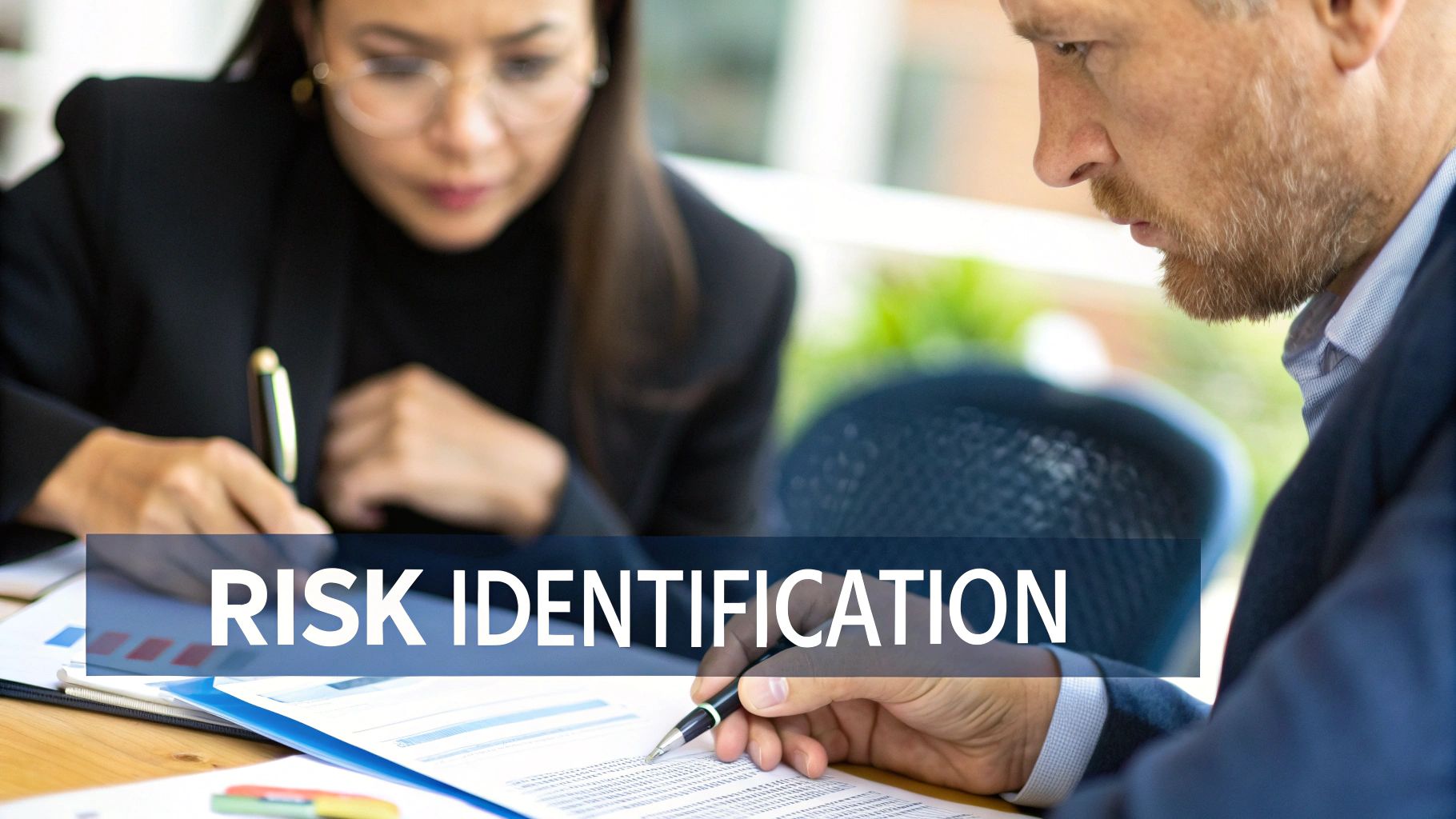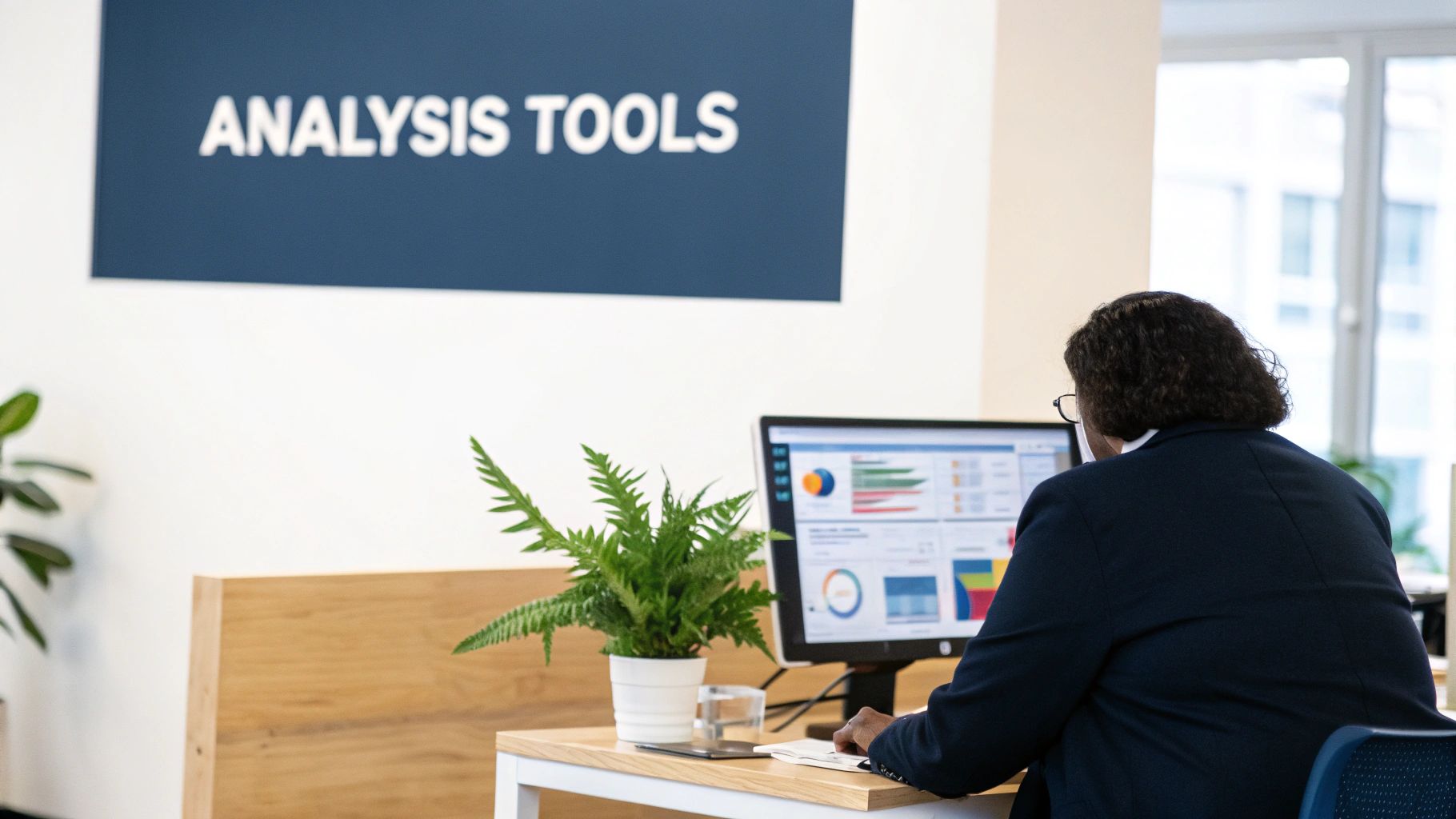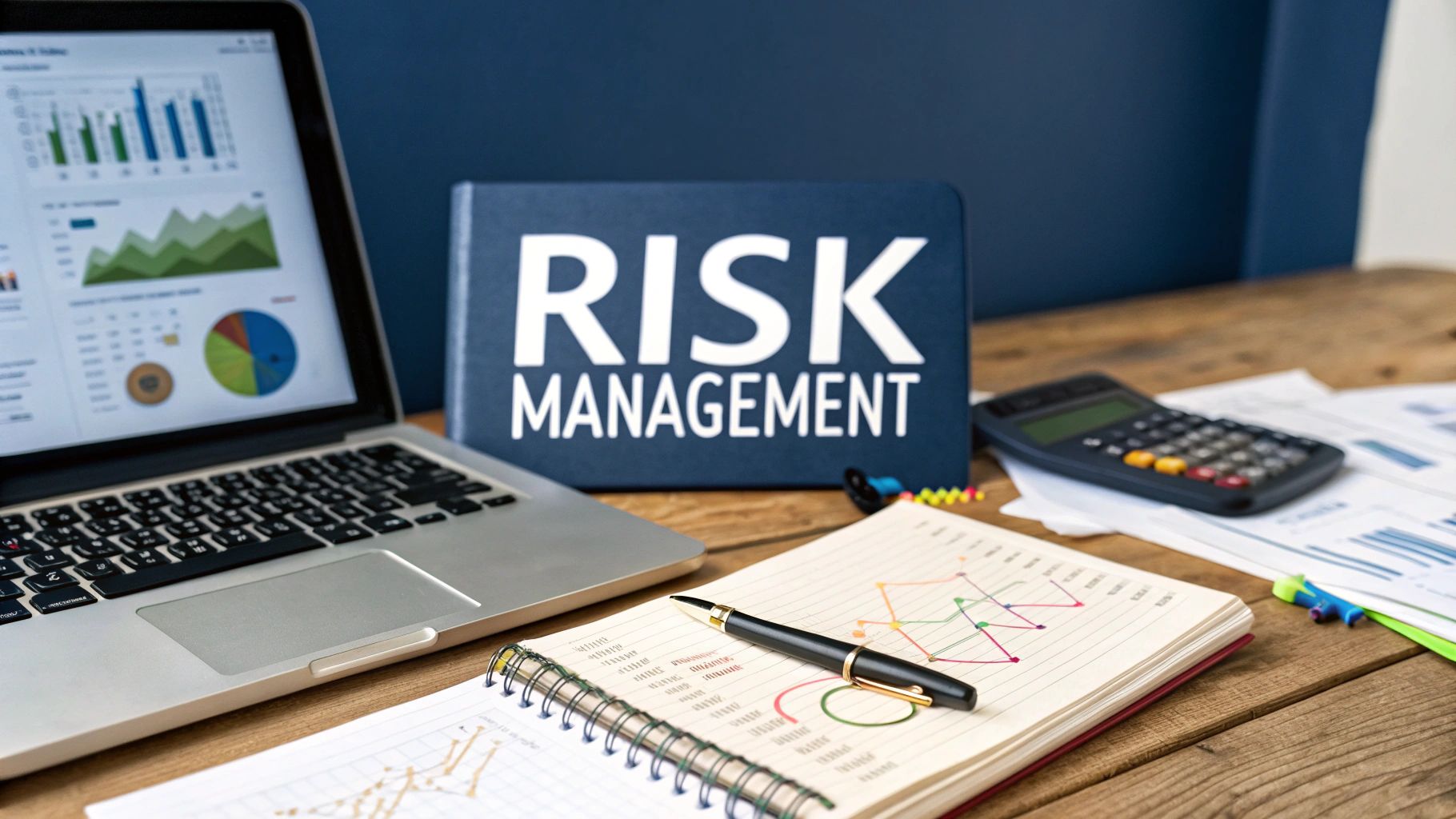Building Your Risk Management Foundation

A strong risk management framework is more than just checking boxes - it's about creating practical systems that protect your organization. The key is building structures that match your specific needs while maintaining clear oversight. Let's explore how to develop a framework that actually works.
Core Elements of a Risk Management Framework
Every effective framework needs these essential pieces:
Risk Identification and Assessment: Finding and evaluating potential threats is critical. Recent studies show that 41% of organizations faced three or more major risk events in just one year. This highlights why having a solid plan for each identified risk is so important, from improving security to updating policies. Learn more about risk management approaches.
Clear Oversight: Set up straightforward management structures where everyone knows their role. Get input from people at every level to make sure nothing falls through the cracks.
Making the Framework Work for You
Adapt these core elements to fit your organization:
Pick What Works: Choose the parts that address your specific challenges and goals
Keep It Simple: Create structures that can change when needed but still maintain control
The best frameworks do more than just follow rules - they help build real protection against risks. This means dealing with common issues like employee resistance and finding ways to work with current systems.
Solving Common Problems
Here are practical ways to move beyond basic compliance:
Build Better Awareness: Give your team the tools and channels they need to spot and report risks. When people feel ownership over risk management, they're more likely to help prevent problems.
Use Smart Tools: Bring in helpful tech to track and report on risks. The right tools can catch issues faster and with fewer mistakes than manual processes.
Connecting Risk Management to Business Goals
Make sure your framework supports what your organization wants to achieve:
Define Success: Be specific about what good risk management looks like for your organization
Keep It Current: Check and update your approach as your business grows and new risks emerge
By focusing on these key areas, you can create a risk management system that both protects your organization and helps it grow. When done right, good risk management becomes a strength rather than just another task.
From Data History to Risk Strategy
Making informed decisions in risk management requires more than current data - past events and patterns hold valuable lessons. By studying historical records, companies can spot potential risks early and create plans to address them before they become problems. This shifts risk management from reactive responses to informed preparation.
Finding Hidden Patterns in Past Data
Looking at historical data is like having a roadmap of what might happen next, backed by real evidence. Take a retail store reviewing five years of sales data - they might notice sales consistently drop during certain months due to seasonal changes. Armed with this knowledge, they can adjust inventory and plan promotions ahead of time to minimize losses. Similarly, tracking past security issues can reveal weak points in systems that need fixing. By using these insights proactively, businesses stay better protected against disruptions.
Quality Data: The Building Blocks of Good Analysis
Creating reliable risk predictions starts with having clean, accurate data. Just as using poor materials leads to structural problems in construction, working with flawed data produces misleading insights. Key elements include:
- Identifying trustworthy data sources
- Using appropriate analysis tools
- Maintaining data quality
- Implementing proper extraction, transformation, and loading (ETL) processes
The analysis process involves several steps:
- Gathering data from internal records, government sources, research, and industry reports
- Cleaning and preparing the data
- Using statistics and visualization to find patterns
- Applying more complex tools like regression analysis when needed
For example, this helps identify seasonal patterns or long-term trends that affect risk levels. These findings then guide practical risk management decisions. Learn more about using historical data for risk analysis.
Managing Data Hurdles
Working with historical data comes with specific challenges. Data often has gaps, inconsistencies, or format differences. Think of it like putting together a puzzle where some pieces are missing or don't quite match - you need careful organization to create a clear picture. This means:
- Filling in missing information
- Fixing errors
- Converting everything to consistent formats
Taking time to clean and standardize data ensures the resulting analysis is reliable and useful.
Creating Future Risk Forecasts
Clean data enables organizations to build models that predict potential risk scenarios. Using statistical methods, these models examine past trends to understand what causes risk events. This helps companies prepare for and reduce future risks. The approach can range from basic trend analysis to advanced machine learning, depending on the specific risk and available data. Like meteorologists use weather patterns to forecast conditions, risk managers use historical data to make informed decisions about potential threats. This data-driven approach helps organizations build stronger risk management systems.
Mastering Statistical Methods for Risk Assessment

Numbers tell stories about risk - but only if you know how to read them properly. Organizations that excel at managing risk rely heavily on statistical analysis to spot patterns and make better decisions. This approach gained even more importance after 2008, when the financial crisis exposed serious flaws in how companies were measuring risk. In response, regulations like the Basel Accords made statistical methods a core requirement for risk assessment. Learn more about statistical methods in risk management.
Picking the Right Tools for the Job
Think of statistical methods like tools in a toolbox - you need to pick the right one for each task. Simple problems might only need basic probability calculations, while complex scenarios call for advanced techniques like Monte Carlo simulations. It's similar to playing poker - just as players calculate odds based on the cards they can see, businesses use statistics to evaluate possible outcomes and their likelihood.
Making the Numbers Make Sense
Even the best analysis is worthless if nobody understands it. The key is translating complex statistical findings into clear insights that drive action. Good visuals make a huge difference here.
Key tips for clear communication:
- Use clear graphs to show trends and relationships at a glance
- Skip the jargon - explain things in plain language everyone can follow
Watch Out for These Common Mistakes
Statistics are powerful but can be misleading if used incorrectly. Relying too heavily on past data without considering new factors is like driving while only looking in your rearview mirror - you'll miss what's coming up ahead.
Getting It Right
To make statistical analysis work for risk management:
- Test your models regularly against real results
- Listen to experts who know your industry - numbers alone don't tell the whole story
Good statistical analysis helps organizations spot threats early and respond effectively. The key is choosing appropriate methods, explaining findings clearly, and staying aware of potential pitfalls. This creates a solid foundation for managing both current and future risks.
Implementing Advanced Risk Assessment Techniques
Risk management is essential for protecting any organization. The risk management framework has changed significantly in recent years to address increasingly complex market conditions. One key tool is Value at Risk (VaR), which helps financial institutions measure potential portfolio losses. VaR estimates the maximum expected loss over a specific timeframe under normal market circumstances, at a given confidence level. While VaR proved useful, its limitations became clear during the 2008 financial crisis, leading firms to develop additional approaches for measuring tail risk. Learn more about this development in quantitative risk management(423s).pdf).
Building on Traditional Methods
Companies now combine VaR with other measurement tools to create a more complete view of risk. For instance, stress testing shows how portfolios perform in extreme market conditions, while scenario analysis examines outcomes from specific hypothetical events. These methods help banks and investment firms spot potential problems before they occur.
Making It Work in Practice
The key to success is matching risk assessment methods to your organization's specific needs and capabilities. Here are practical ways to implement these approaches:
- Use Multiple Methods: Combine different risk measures to understand various types of risk exposure
- Apply Technology: Choose appropriate software tools to handle complex calculations and data analysis
- Update Regularly: Review and adjust models as market conditions and business needs change
Overcoming Common Obstacles
Setting up new risk systems comes with real challenges. Organizations often struggle with incomplete data, technical issues when implementing new systems, or employee reluctance to change existing processes. Here's how to address these issues:
- Focus on Data Quality: Make sure your data is accurate and complete
- Invest in Learning: Give teams the training they need to use new tools effectively
- Build Support: Get buy-in from key people across departments to help changes succeed
By bringing together proven methods with new quantitative approaches and the right technology, organizations can better measure and manage their risks. This leads to stronger decision-making based on clear, data-driven insights rather than gut feelings.
Driving Measurable Framework Performance

The key to making a risk management framework truly valuable is knowing how to measure and track its impact. Leading companies do this well by carefully selecting Key Performance Indicators (KPIs) that match their risk goals. By tracking the right metrics, risk managers can show concrete results while staying focused on protecting their organization.
Key Performance Indicators and Metrics
Choosing meaningful KPIs helps organizations track what matters most. The best indicators go beyond basic compliance to support broader business goals. Common KPIs include:
- Risk Reduction: Measuring how much risk exposure decreases over time
- Response Speed: Tracking how quickly teams handle incidents
- Compliance Rates: Checking how well the organization follows key regulations
Recent studies show mixed results in framework effectiveness. While 57% of risk teams report better decision-making from using risk data, only 30% see lower compliance costs. Learn more about risk management outcomes.
Implementing Effective Monitoring Systems
Good monitoring helps spot issues early. Modern tools can automatically track KPIs and flag concerns, reducing manual work and human error. This gives teams real-time insights to address problems quickly.
Key monitoring practices include:
- Automated Data Collection: Making tracking easier and more accurate
- Regular System Checks: Verifying everything works as intended
- Visual Reports: Using clear dashboards to spot trends and issues
The goal is to catch and fix problems fast while maintaining solid risk management practices.
Driving Continuous Improvement
Getting better over time requires regular reviews and updates. This means learning from incidents, adapting to new rules, and staying ahead of emerging risks.
Best practices for improvement:
- Review Past Events: Learn from what went wrong to prevent repeat issues
- Build Team Skills: Help everyone understand their role in risk management
- Keep Communication Open: Share progress and changes with all stakeholders
Making improvement a regular habit helps organizations stay resilient. When teams commit to getting better at managing risk, they're more likely to spot and handle threats successfully.
Building a Future-Ready Risk Framework

Having a strong risk management framework means more than just setting rules and procedures. Your system needs to grow and adapt with your business while maintaining solid controls. Let's look at how successful companies build frameworks that stay effective through change and uncertainty.
Responding to New Threats and Opportunities
Business risks and opportunities shift constantly. Modern frameworks help companies spot emerging challenges early - from sophisticated cyber attacks to supply chain problems. More importantly, they enable quick action when good opportunities arise. For instance, when a company spots a chance to enter a promising new market, a well-designed framework helps evaluate and manage the associated risks.
Making Your Framework Adaptable
Think of your risk framework like building blocks - you want a solid foundation that you can modify as needed. This modular approach maintains control while allowing you to swap out or add pieces as circumstances change. The goal is responding quickly to surprises while keeping core safeguards in place.
Using New Tools Wisely
Technology creates both opportunities and risks for managing uncertainty. Smart companies carefully test new tools like AI-powered risk detection and blockchain tracking. At the same time, they plan for technology-specific challenges like data security and system reliability through thorough testing and backup procedures.
Staying Ahead of Rule Changes
Rules and regulations change often. An adaptable framework helps you spot upcoming changes early and adjust internal policies before problems arise. This forward-looking mindset minimizes disruptions and keeps you in compliance.
Creating a Sturdy Framework
Strong frameworks prepare for trouble before it hits. This means having backup plans, testing key systems regularly, and making sure everyone understands their role in managing risk. When problems do arise, these preparations help maintain operations and bounce back quickly.
Key Steps to Keep Your Framework Current
Here's how to make sure your framework stays effective:
- Review Regularly: Check how well your framework handles current risks and where it needs updates
- Test Different Scenarios: Run through "what-if" situations to find weak spots
- Get Team Input: Ask people across departments to help spot emerging issues
- Keep Learning: Study what works for other organizations and stay current on best practices
Want to think differently about risk and opportunity? The Covered Call Podcast features conversations with entrepreneurs and investors who found success by questioning standard approaches. Join hosts Jason Nutter and Lovis Kauf for practical insights on building wealth while staying true to your principles.

